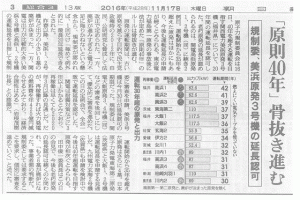Original Japanese written by Kay Ikezumi, Secretary General.
The English below written and arranged by Heeday, based on the original Japanese
The English edited by Rev. Dr. Henry French, ELCA
Japan’s Nuclear Regulation Authority (NRA), on November 16th, gave a go-ahead to the extended operation of Unit 3 of The Kansai Electric Power’s Mihama Nuclear Power Station (hereafter “KEPCO” and “Mihama NPS,” respectively). Located in Mihama, Fukui Prefecture, Japan (some 47 miles north-northeast of Kyoto), the old NPP has been at work over the last four decades. This is the third aged reactor whose “prolongation” has been approved, following Units 1 and 2 of KEPCO’s Takahama Nuclear Power Plant (NPP).
Following the disaster of TEPCO’s Fukushima Daiichi NPP, the NPP safety laws were revised in 2011 to eliminate outdated NPPs. Under the revised safety laws, Japan has a “40-year of operation” regulation. There is, however, an exemption to this. The NRA can authorize an old NPP’s “prolongation” of operation, just once, for up to 20 additional years, as a “highly exceptional case,” since applying the “40-year rule” strictly would eliminate many reactors, which might result in a power shortage.
The approval of Mihama Unit 3’s prolongation is making “highly exceptional cases” commonplace. At present, what practical meaning does the “40-year rule” have? Many are seriously worried that we might see more and more aged reactors’ lives prolonged.
The Mihama NPS marks its 40th year of operation this November, and should have been decommissioned, if the NRA had not approved its prolongation.
The Authority claims it has confirmed that a major accident would not destroy Unit 3’s reactor vessel. When the Fukushima Daiichi disaster hit, however, most media reported that the “myth of NPP safety has broken down.” So, where has this lesson gone?
KEPCO says it will spend some JPY165 billion on reinforcing the unit, to make it resistant to earthquakes and tsunamis. The reinforcement work should be finished in 2020, after which the reactor is to be restarted. Despite this gigantic investment, at a regular press meeting last October, KEPCO’s President, Shigeki Iwane, emphatically stated: “We believe the restart work should pay off economically.”
Recently, India and Japan signed a civil nuclear agreement. One result of the deal is that many of Japan’s reactor providers—now that it is next to impossible to build a new NPP in Japan—can now count on India’s market as a major NPP export target.
The restart approval and the nuclear agreement stand on the same principle—money matters more than life. Life is disregarded for money.
In the aftermath of the Fukushima Daiichi disaster, currently almost 100,000 Fukushima citizens are still living as evacuees, to avoid exposure to radioactivity and other hazards, in places far away from their hometowns. They have already been living as refugees for 5.5 years now, and this has cost many of them their health. Many aged evacuees are living in isolation, which adversely affects their health, both mentally and physically, while some have chosen to commit suicide.
The Fukushima Daiichi disaster has deprived those citizens of their ordinary living, exposed them to radiation, and left behind gigantic heaps of radioactive waste. Also, the decommissioning of the NPP has a long, winding way to go. None of these grave issues have so far been resolved. Still, there is a mega trend in Japan to approve NPP life prolongation, permit NPP restarts, and export NPPs.
We need to stand up against this trend. Otherwise, it will run wild.
Below: Article from the November 17th, 2016 edition of the Asahi Shimbun newspaper

